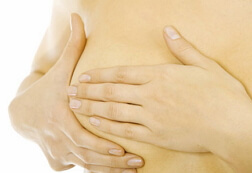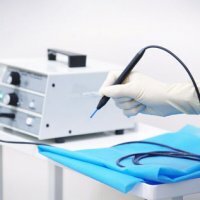Breast cyst
 Breast cyst are single or multiple cavities with a capsule and liquid contents in the mammary glands that are benign in nature. Breast cysts are found among patients of any age. These formations with a well-expressed fibrous capsule, filled with a transparent non-inflammatory fluid, are often rounded and small in size( not more than 5 cm).Most breast cysts look the same and differ only in size. Sometimes women may have an atypical cyst of the breast with cavities extending into the cavity.
Breast cyst are single or multiple cavities with a capsule and liquid contents in the mammary glands that are benign in nature. Breast cysts are found among patients of any age. These formations with a well-expressed fibrous capsule, filled with a transparent non-inflammatory fluid, are often rounded and small in size( not more than 5 cm).Most breast cysts look the same and differ only in size. Sometimes women may have an atypical cyst of the breast with cavities extending into the cavity.
Perhaps, there are hardly two women with the same mammary glands. They each have individual external signs, but their internal structure is identical for all.
The breast is formed mainly by a glandular tissue, which is evenly distributed under the skin in the surroundings of fatty tissue. Through the thickness of each mammary gland, tendons of connective tissue stretch, dividing it into several( about 20) large lobes. Each large fraction branches into smaller segments. In the lobules are small glands( alveoli), they produce milk. The terminal ducts of the alveoli extend to the surface of the nipple. Mammary gland tissue is abundantly supplied with blood and lymphatic vessels.
The cyst of the breast is formed as a result of the widening of its duct. In the formed cavity there is accumulation of glandular secret, it clogs the duct and is encapsulated.
Sometimes in the mammary glands are found fatty cysts. They are not associated with the secretory function of glandular tissue, but are formed due to blockage of the sebaceous gland.
Most breast cysts are single-chamber, that is, they have one cavity with a liquid. If septa form partitions, a solitary cyst of the breast with several fluid cavities is formed.
The reasons for the development of cysts in the mammary glands have not been studied enough. A reliable condition for their development is hormonal imbalance.
Cysts of small size usually do not cause subjective sensations and can be detected by chance. Before menstruation, when the mammary glands swell and squeeze a large cyst, a feeling of discomfort or mild soreness may appear.
The small size of a breast cyst does not allow to reveal it during general examination and palpation. Medium and large cysts, as a rule, are initially discovered by women themselves. Significantly complicate the primary diagnosis of infrequently occurring large sizes of the mammary gland cyst and its irregular shape, since such formations are difficult to differentiate.
The presence of a breast cyst is confirmed by two simple and accessible studies: ultrasound scanning and mammography. After clarifying the localization of the cyst, an aspiration biopsy of its contents is performed, which is sent for cytological examination.
Any atypical cyst of the breast requires additional diagnostic measures. Aspiration biopsy is mandatory, and the resulting material is studied in a histological laboratory.
There is a misconception that a breast cyst without proper treatment "will resolve itself".Indeed, in very rare cases, the cyst is independently opened and disappears. However, the ability of the cyst to continue to accumulate glandular secret and increase may lead to the fact that instead of simple medical measures with a small cavity formation, the doctor will have to remove a large complicated cyst. In addition, without appropriate correction of hormonal disorders, any cyst can return, or be accompanied by the appearance of new ones.
Small cysts, as a rule, are treated conservatively. For cysts larger than 15 mm, it is advisable to remove them. A thin-needle puncture of the mammary gland cyst and evacuation of its contents is performed.
Contrary to the prevailing opinion among patients that the breast cyst is healthy or life-threatening, removal of the breast cyst does not alter its function. Problems appear in the case of large cysts, and if the cyst is inflamed or inflamed.
The term ductal cyst of the breast is used less often than its other name - intraprostatic papilloma. Externally, the ductal cyst resembles a cavity with thick brown or bloody contents, filled with papillary growths. It is isolated as an independent nosological unit and is considered unfavorable in terms of development of the oncological process. And, although a dangerous degeneration of the ductal cyst happens extremely rarely, it must be surgically removed.
Causes of the breast cyst
More often, breast cysts are detected in women older than thirty years. For a variety of reasons, the milk ducts begin to expand unevenly, the glandular secret accumulates and stagnates in the areas of their expansion. By consistency, it can be liquid or thick and viscous. Over time, the outflow of the contents of the duct ceases, and a cavity with liquid contents is formed therein. If the cyst is formed in the terminal section of the milk duct, it eventually can separate from it and exist autonomously.
The older the cyst, the thicker its capsule. The contents of the breast cyst can be of different colors: brown, yellowish, dark green. In the cystic cavity, dense inclusions can occur, if the cyst exists long enough, they can be transformed into pieces of lime. The inner surface of the capsule of the cyst is usually smooth, with the exception of an atypical cyst of the breast with the presence of tubercles on the inner surface.
The mechanism of formation of the breast cyst is much better studied than its causes. The only reliable reason for the formation of cysts in the tissues of the breast is hormonal dysfunction. It can be said that any condition, accompanied by a violation of the normal ratio of sex steroids, increases the risk of developing a breast cyst.
Cases predisposing to the formation of cysts are:
- Fibrocystic mastopathy. Cysts in the mammary glands are revealed in every third patient with mastopathy developing against a background of excess estrogens.
- Lack of delivery and breastfeeding.
- Long( more than five years) uncontrolled intake of hormonal contraception. If the drug is chosen correctly on the basis of studying the features of the patient's hormonal function, it is not a source of cyst formation in the mammary gland. The risk of their appearance increases in situations where patients choose their own contraceptive and take it for a long time without the necessary interruptions.
- Endocrine Disorders. The hormonal function of the ovaries is in close interaction with the work of all the endocrine glands in the body. Thyroid dysfunction, diabetes mellitus and other endocrine pathologies affect the normal ratio of sex steroids and can lead to the formation of cysts in the mammary glands.
- Stressful situations. When excessive psychoemotional stress changes the stability of the hormonal balance and metabolism in the body.
- Overweight. Adipose tissue is an additional source of estrogens. With increasing weight, their amount in the body can increase.
- Gynecological ailments accompanied by hormonal disorders.
None of the known causes and none of the risk factors can be considered absolutely reliable, because their presence does not always provoke the formation of cysts in the tissues of the breast.
Symptoms of the breast cyst
The presence of clinical signs of the breast cyst, their severity depends on the size of the formation. Small cysts( and sometimes their size does not exceed 3 mm) in the absence of growth can be asymptomatically present in the mammary gland for years and come to light accidentally. Medium and large( up to 5 cm or more) cysts can cause a feeling of discomfort and easy soreness, especially on the eve of a regular menstruation against a background of fluid retention in the tissues of the mammary glands. Sometimes a cyst may be accompanied by periodic discharge from the nipple, this is due to the release of the contents of the cyst into the milk duct of the gland, it has a liquid or thick consistency, yellow, greenish or almost transparent. Such a discharge from the breast can accompany other diseases, more often - mastopathy, so the symptom is not significant.
Cysts of large size are often visible when viewed externally, when an elevation or "bump" is visualized on the surface of the chest.
It is noted that the right breast cyst is less common than the left breast cyst in young patients.
Breast cysts often accompany mastopathy, namely its fibrocystic form, so a patient with a cyst often has symptoms of mastopathy, which is the real culprit in the occurrence of pain in one or both mammary glands, and not actually the cyst. The nature of pain is very diverse and varies from mild discomfort to severe pain. In addition to pain in mastopathy, the mammary gland palpable painful areas of compaction of various sizes, shapes and densities that make the initial diagnosis of the cyst difficult.
Both mammary glands have an almost symmetrical structure, therefore the right breast cyst and the left breast cyst do not differ in clinical signs and structure.
During self-examination of mammary glands, women often themselves can detect cysts of medium or large size. It is palpated as a round, smooth formation of a soft-elastic consistency. However, it is impossible to determine the exact nature of any education found during the probing without additional survey methods.
The presence of a cyst in the mammary gland in most cases is confirmed by two leading diagnostic methods:
- The method of ultrasound scan of mammary glands. It is performed in the first phase of the cycle in young women( up to 40 years) with a dense structure of the mammary glands. It allows to reveal very small( less than 5 mm) cysts and to determine their internal structure, and also it is able to differentiate the cavity formation from the tumor-like one. The cyst during examination looks like a rounded, clearly delineated formation with liquid contents, which has a well-expressed capsule, and the solitary cyst of the breast looks like a compartment divided by septa. All segments of the mammary gland are examined, the condition and dimensions of its ducts are evaluated, and the lymph nodes surrounding the gland are scanned.
- Radiographic examination( mammography).It is shown to women who have overcome the forty-year boundary. It is an accessible and informative method, can detect even the deepest located in the mammary gland pathological formations. Allows you to take pictures of the problematic site of the gland in several projections with an increase.
In difficult clinical situations it is possible to carry out MRI.
Once a cyst is detected using ultrasound or mammography, you need to determine how it is filled. Since in the breast some malignant formations masquerade as an innocuous cyst, one should determine its good quality, that is, look at what cells it consists of. For this, a puncture( piercing) of the cyst is performed by means of a thin needle, followed by the evacuation of its contents. The resulting material is sent for study.
Because the mammary gland cyst is considered as a hormone-dependent process, all patients are shown a laboratory study of the state of hormonal function. If the unfavorable background for the formation of cysts is not eliminated during therapy, the cyst may recur, or be formed elsewhere.
Breast cysts can be inflamed, infected and inflamed. In such situations, patients develop signs of acute infectious inflammation.
Large, and even giant cysts disrupt the structure of the mammary glands. In addition to visible deformity of the breast, pain is noted due to compression of tissues surrounding the gland.
Treatment of a breast cyst
When the diagnosis of a breast cyst becomes final, the question of a method for its elimination is decided.
Small uncomplicated cysts, not exceeding 15 mm, require conservative treatment and follow-up. Sometimes, for the complete elimination of even a few cysts of the breast, it is enough to correct the work of the endocrine system and restore the proper hormonal function.
Hormonal treatment for cysts of the breast is carried out in accordance with the nature of hormonal dysfunction. The goal of the treatment is a normal two-phase cycle.
All patients are recommended a rational diet with a minimum of animal fats and a high content of vegetable fiber. No special diet "for weight loss" is not necessary, a little to adjust the diet.
The correct physical load helps restore the general tone of the body, speeds up metabolism and improves mood. In order to restore normal physical activity it is enough to walk more, to work at home or to walk in the park.
The mammary gland is very sensitive to stress. Psychoemotional overloads provoke the formation of many pathologies in the mammary gland, including cysts. The complex of therapeutic measures always includes sedative therapy.
Fine-needle puncture of the mammary gland cyst( piercing of its cavity) is carried out at their medium and large sizes in case of an increase in size and discomfort. After puncturing the capsule of the cyst, its contents are pumped out with a syringe. The walls of the empty cyst fall off and it disappears. However, if there is a small amount of fluid left on the cyst site, it can return. To prevent such a scenario, after evacuation of the contents of the cyst, sclerotherapy is performed - the introduction into the cystic cavity of a substance that causes a tight adherence of its walls.
If abnormal growths or atypical cells are found in the cyst, removal of the mammary gland, regardless of its size, is indicated. Multiple, multiple cysts are also subject to surgical treatment.
After the elimination of the breast cyst, the patient needs a dynamic observation and regular examination.
Breast cysts operation
The removal of the mammary gland cyst is performed by sectoral resection. During the operation, not only the cyst is removed, but the area of the surrounding tissue( sector) is excised. In fact, a small part of the mammary gland is removed from the cyst located in it. To ensure that the rough postoperative scars do not deform the breast and not break its aesthetics, the wound is sutured with cosmetic sutures.
For a few days after removal of the cyst in the postoperative wound, drainage is left - a special tube through which fluid drains from the wound. Drainage does not allow the fluid to accumulate inside the wound cavity and cause complications.
When the patient is still on the operating table, the tissue removed by resection is sent for an urgent histological examination. Half an hour later, when a response from the laboratory is received, the further outcome of the operation is decided. If the material does not show "bad" cells, the amount of the performed surgery is considered sufficient, and the wound is sutured. In a negative scenario, unilateral removal of the mammary gland and adjacent axillary lymph nodes takes place.
Breast resection is not a complex operation. As a rule, it passes without negative consequences. But, like any surgical intervention, they can be accompanied by complications.
After the operation, infection of the wound can occur with subsequent suppuration. This happens infrequently, as the patient is prescribed a course of antibiotics. The wound has to be opened, the cavity is cleaned of pus and treated with antibiotics.
If during the operation the bleeding has stopped bleeding correctly, blood may accumulate in the wound cavity and a hematoma may form. It must be opened.
Breast cysts - what to do?
The fear of any formations in the mammary gland is associated with the thought that they can turn out to be malignant processes. Meanwhile, in the modern world, cancer has not always been a death sentence for a long time, but can be detected in the early stages and removed, leaving the woman healthy for many years.
Breast cyst does not refer to ailments that should be feared. It almost never transforms into cancer. Small cysts respond well to simple conservative treatment.
The opinion that cysts are helped only by surgery or only by hormonal therapy is incorrect. In the treatment schemes often lead the preparations on a plant basis or homeopathic remedies. Very popular are also containing iodide compounds( Mamoclam) or extracts from cruciferous( indinol) drugs.
Instead of the "old" list of broths that require time for cooking, ready-made tablets or extracts have appeared. They contain the optimal set of medicinal herbs, which positively influences metabolism and the immune system. Also, these herbs tidy up the psycho-emotional sphere.
If it seems to you that there is an incomprehensible compaction in the chest, do not sit at home and be afraid, contact a gynecologist or mammologist. If you have not reached the age of forty, you will have to undergo ultrasound of the mammary glands( mammography, if you are older), check the level of hormones and their ratio.
Most of the lesions in the mammary glands, especially if they are associated with pain and change cyclically, are a sign of hormonal and emotional distress, and their timely treatment will help to maintain good health.



